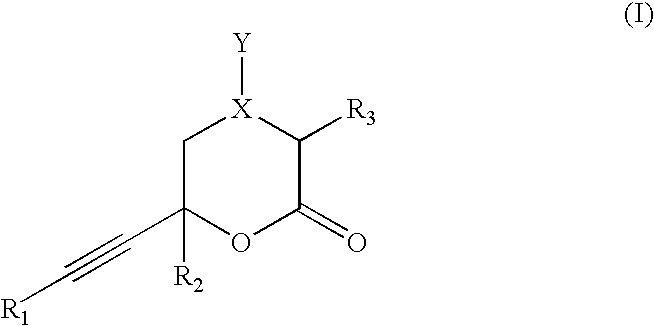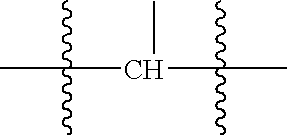Inhibitors of hepatitis C virus RNA-dependent RNA polymerase, and compositions and treatments using the same
- Summary
- Abstract
- Description
- Claims
- Application Information
AI Technical Summary
Benefits of technology
Problems solved by technology
Method used
Image
Examples
example 1
6-cyclopentyl-6-[(4-methoxyphenyl)ethynyl]dihydro-2H-pyran-2,4(3H)-dione
Step 1: 6-(2-cyclopentyl-2-hydroxy-4-trimethylsilanyl-but-3-ynyl)-2,2-dimethyl-[1,3]dioxin-4-one
A solution of diisopropylamine (3.85 mL, 27.5 mmol) dissolved in THF (100 mL; dry) was cooled to −78° C., where BuLi (11 mL, 27.5 mmol; 2.5 M in hexanes) was added dropwise over 10 minutes. After stirring at this temperature for 5 minutes, the mixture was warmed to room temperature for 5 minutes, then cooled back to −78° C., where 2,2,6-trimethyl-[1,3]dioxin-4-one (3.60 mL, 27.5 mmol)(available from Aldrich) was added dropwise over 5 minutes, then stirred an additional 30 minutes at −78° C. To this solution was added 1-cyclopentyl-3-trimethylsilanyl-propynone (4.85 g, 25 mmol), which was prepared as described in J. Org. Chem., 106:4786-4800 (1984) (1H NMR (CDCl3): δ0.24 (s, 9H), 1.63 (m, 4H), 1.90 (m, 4H), 2.92 (pentet, 1H, J=8.2 Hz)), over 5 minutes. The resulting mixture was stirred at −78° C. for 1 hour, then slow...
example 2
Cyclopentyl-6-(1,3-thiazol-2-ylethynyl)dihydro-2H-pyran-2,4(3H)-dione
Step 1: 6-(2-cyclopentyl-2-hydroxy-4-thiazol-2-yl-but-3-ynyl)-2,2-dimethyl-[1,3]dioxin-4-one
To a degassed solution of 6-(2-cyclopentyl-2-hydroxy-but-3-ynyl)-2,2-dimethyl-[1,3]dioxin-4-one (264.1 mg, 1.0; prepared as described in Example 1, Step 2), 2-bromothiazole (99.1 μL, 1.1 mmol), diisopropylamine (1.5 mL), and DMF (0.5 mL), under argon, was added Pd(PPh3)2Cl2 (28.1 mg, 0.04 mmol) and Cul (15.2 mg, 0.08 mmol). The resulting mixture was vacuum-flushed with argon (3×), then placed in 100° C. oil bath for 5 minutes, during which time the reaction becomes black / brown in color. The mixture was filtered through a plug of silica eluted with ethylacetate, concentrated, and purified by flash chromatography using 30% EtOAc / Hex as the eluent. The yield of product was 280 mg (81% yield). 1H NMR (CDCl3): δ 1.63 (m, 4H), 1.72 (s, 3H), 1.73 (s, 3H), 2.23 (pentet, 1H, J=8.0 Hz), 2.54 (s, 1H), 2.65 (s, 2H), 3.81 (s, 3H), 5.47 (...
example 3
6-cyclopentyl-6-methyl-dihydro-pyran-2,4-dione
The title compound was prepared analogously to Example 1, except 3-bromobenzene was used in place of 4-bromoanisole in Step 3 of that example. 1H NMR (CDCl3): δ 1.24 (d, 6H, J=7.0 Hz), 1.55-2.05 (bm, 4H), 2.45 (pentet, 1H, J=8.3 Hz), 2.74 (d, 1H, J=17.5 Hz), 2.45 (m, 1H), 3.00 (d, 1H, J=17.5 Hz), 3.47 (d, 1H, J=19.8 Hz), 3.97 (d, 1H, J=19.8 Hz), 7.46 (m, 4H). Anal. Calcd. For C21H24O3.0.15 H2O: C, 77.1; H, 7.49. Found: C, 77.14; H, 7.63; ESIMS (M−H−): 323.2.
PUM
| Property | Measurement | Unit |
|---|---|---|
| Pharmaceutically acceptable | aaaaa | aaaaa |
Abstract
Description
Claims
Application Information
 Login to View More
Login to View More - R&D
- Intellectual Property
- Life Sciences
- Materials
- Tech Scout
- Unparalleled Data Quality
- Higher Quality Content
- 60% Fewer Hallucinations
Browse by: Latest US Patents, China's latest patents, Technical Efficacy Thesaurus, Application Domain, Technology Topic, Popular Technical Reports.
© 2025 PatSnap. All rights reserved.Legal|Privacy policy|Modern Slavery Act Transparency Statement|Sitemap|About US| Contact US: help@patsnap.com



